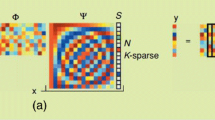Abstract
Conventional image steganalysis mainly focus on presence detection rather than the recovery of the original secret messages that were embedded in the host image. To address this issue, we propose an image steganalysis method featured in the compressive sensing (CS) domain, where block CS measurement matrix senses the transform coefficients of stego-image to reflect the statistical differences between the cover and stego- images. With multi-hypothesis prediction in the CS domain, the reconstruction of hidden signals is achieved efficiently. Extensive experiments have been carried out on five diverse image databases and benchmarked with four typical stegographic algorithms. The comprehensive results have demonstrated the efficacy of the proposed approach as a universal scheme for effective detection of stegography in secure communications whilst it has greatly reduced the numbers of features requested for secret signal reconstruction.





Similar content being viewed by others
References
AlKhateeb JH et al (2008) Word-based handwritten Arabic scripts recognition using DCT features and neural network classifier. Proc 5th Int Multi Conf Syst, Sign Dev: 1–5
Candes E, Tao DC (2006) Near optimal signal recovery from random projections: universal encoding strategies. IEEE Trans InfoTheory 52(12):5406–5425
Davenport M, Boufounos P, Wakin M, Baraniuk R (2010) Signal processing with compressive measurements. IEEE J Select Topics Sign Process 4(2):445–460
Dong J, Chen X, Guo L, Tan T (2008) Fusion based blind image steganalysis by boosting feature selection. LNCS 6387:87–98
Donoho D (2006) Compressed sensing. IEEE Trans Info Theory 52(4):1289–1306
Duarte MF, Eldar YC (2011) Structured compressed sensing: from theory to applications. IEEE Trans Sign Process 59(9):4053–4085
Fingerprint verification competition (2017) http://biometrics.cse.msu.edu/fvc2004db/index.html. [Assessed on 25 August 2017]
Fowler JE, Mun S, Tramel EW (2011) Multiscale block compressed sensing with smoothed projected landweber reconstruction. Proc 19th Eur Sign Process Conf: 564–568
Fridrich J, Kodovsky J (2012) Rich models for steganalysis of digital images. IEEE Trans Info Foren Sec 7(3):868–882
Fridrich J, Goljan M, Soukal D (2004) Perturbed quantization steganography with wet paper codes. Proc ACM Multimed Workshop: 4–15
Gao P, Ren J (2006) Analysis and realization of snort-based intrusion detection system. Comput Appl Softw 23(8):134–135
Gill K et al (2011) Quality-assured fingerprint image enhancement and extraction using hyperspectral imaging. Proc IEEE Int Conf Imaging Crime Detect Prevent
Holub V, Fridrich J (2013) Random projections of residuals for digital image steganalysis. IEEE Trans Info Foren Sec 8(12):1996–2006
Holub V, Fridrich J, Denemark T (2013) Random projections of residuals as an alternative to cooccurrences in steganalysis. Proc SPIE Electron Imag 8665:0L01–0L11
Kodovský J, Fridrich J (2008) On completeness of feature spaces in blind steganalysis. Proc 10th ACM Workshop Multimed Sec: 123-132
Li YB, Guo ZH (2016) Image steganography in a Karhunen-Loeve transform optimization model. Int J Sec Appl 10(5):19–128
Li B, Huang JW, Shi YQ (2008) Textural features based universal steganalysis. Proc SPIE 6819
Lu W, Varna AL, Wu M (2010) Security analysis for privacy preserving search for multimedia. Proc IEEE 17th Int Conf Image Process: 68-72
Orsdemir A, Altun HO, Sharma G, Bocko MF (2008) On the security and robustness of encryption via compressed sensing. Proc IEEE Milit Commun Conf: 1040–1046
Patsakis C, Aroukatos NG (2014) LSB an DCT steganographic detection using compressive sensing. J Info Hiding Multimed Sign Process 5(1):20–32
Pevný T, Bas P, Fridrich J (2010) Steganalysis by subtractive pixel adjacency matrix. IEEE Trans Info Foren Sec 5(2):215–224
Pevný T, Filler T, Bas P (2010) Using high-dimensional image models to perform highly undetectable steganography. LNCS 6387:161–177
Qiao T et al (2017) Effective denoising and classification of hyperspectral images using curvelet transform and singular spectral analysis. IEEE Trans Geosci Remote Sens 55(1):119–133
Ren J, Vlachos T (2007) Efficient detection of temporally impulsive dirt impairments in archived films. Sign Process 87(3):541–551
Ren J et al (2014) Gradient-based subspace phase correlation for fast and effective image alignment. J Vis Commun Image Represent 25(7):1558–1565
Shi YQ, Sutthiwan P, Chen L (2012) Textural features for steganalysis. Proc Int Workshop Info Hiding: 63–77
Steganography software tools (2017) http://members.tripod.com/steganography/stego/software.html [Assessed on 12 Sept. 2017]
Sullivan GJ (1993) Multi-hypothesis motion compensation for low bit-rate video coding. In proc. Int. Conf. On acoustics. Speech Sign Process 5:437–440
Wang Y, Moulin P (2007) Optimized feature extraction for learning based image steganalysis. IEEE Trans Inf Forens Sec 2(1):31–45
Wang Z, Bovik AC, Sheikh HR, Simoncelli EP (2004) Image quality assessment: from error visibility to structural similarity. IEEE Trans Image Process 13(4):600–612
Wang Q, Zeng W, Tian J (2013) Integrated secure watermark detection and privacy preserving storage in the compressive sensing domain. Proc IEEE Int Workshop Info Foren Sec: 67–72
Wang Z et al (2018) A deep-learning based feature hybrid framework for spatiotemporal saliency detection inside videos. Neurocomputing 287:68–83
Westfeld A (2001) High capacity despite better steganalysis (F5 – a steganographic algorithm). Lect Notes Comput Sci 2137:289–302
Yan YJ et al (2018) Unsupervised image saliency detection with gestalt-laws guided optimization and visual attention based refinement. Pattern Recogn 79(7):65–78
Zabalza J et al (2014) Robust PCA micro-Doppler classification using SVM on embedded systems. IEEE Trans Aerospace Electron Syst 50(3):2304–2310
Zhang AZ et al (2018) A dynamic neighbourhood learning-based gravitational search algorithm. IEEE Trans Cybernet 48(1):436–447
Zhao HM et al (2017) Robust information hiding in low-resolution videos with quantization index modulation in DCT-CS domain. Multimed Tools Appl: 1–21
Zhou Y et al (2016) Hierarchical visual perception and two-dimensional compressive sensing for effective content-based color image retrieval. Cogn Comput 8(5):877–889
Acknowledgements
This work was partly supported by the National Natural Science Foundation of China (61672008, 61772144), Guangdong Provincial Application-oriented Technical Research and Development Special fund project (2016B010127006, 2017A050501039), the Natural Science Foundation of Guangdong Province (2016A030311013, 2015A030313672), International Scientific and Technological Cooperation Projects of Education Department of Guangdong Province (2015KGJHZ021), and the Scientific and Technological Projects of Guangdong Province (2017A050501039).
Author information
Authors and Affiliations
Corresponding author
Rights and permissions
About this article
Cite this article
Zhao, H., Ren, JC., Zhan, J. et al. Compressive sensing based secret signals recovery for effective image Steganalysis in secure communications. Multimed Tools Appl 78, 29381–29394 (2019). https://doi.org/10.1007/s11042-018-6065-7
Received:
Revised:
Accepted:
Published:
Issue Date:
DOI: https://doi.org/10.1007/s11042-018-6065-7




